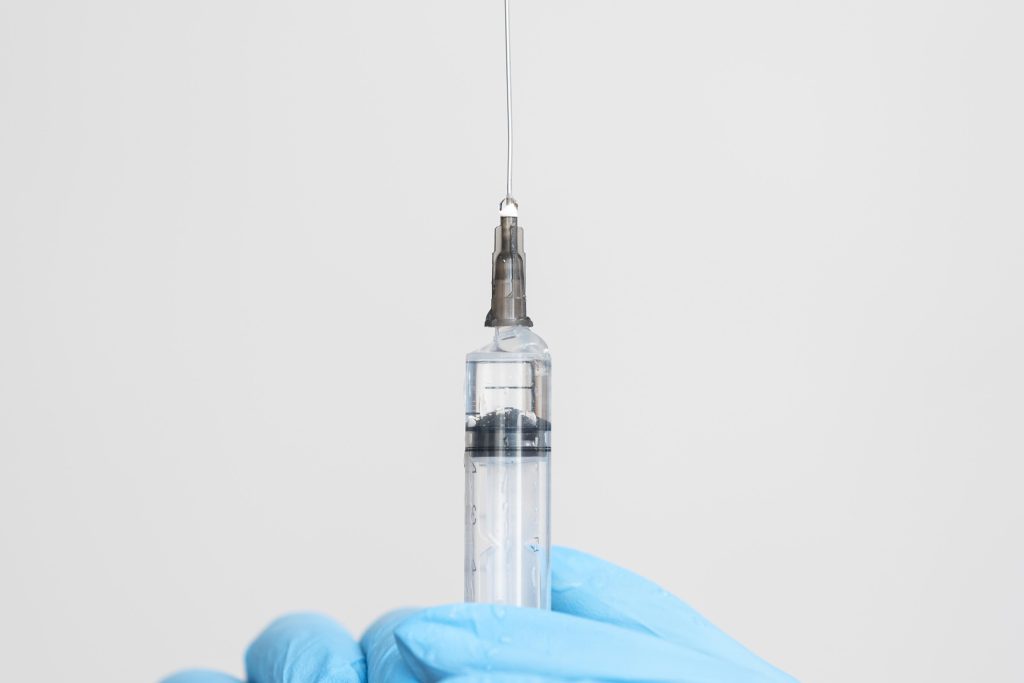Table of Contents
Introduction
Liraglutide and semaglutide are pivotal medications in managing type 2 diabetes and obesity. Both belong to the GLP-1 receptor agonist family, mimicking the glucagon-like peptide-1 hormone to regulate blood sugar and appetite, thus aiding weight loss. Understanding the nuances between liraglutide and semaglutide is vital for patients and healthcare providers. Although similar, these drugs vary in usage, effectiveness, side effects, and cost. This knowledge is crucial for making informed treatment choices.
This article aims to clearly explain the workings, uses, side effects, and administration of liraglutide and semaglutide. By the end, you’ll be equipped with valuable insights into these medications, aiding in the management of diabetes and obesity.
Both liraglutide and semaglutide are synthetic GLP-1 hormones. Naturally released in response to food, GLP-1 stimulates insulin release, lowering blood sugar. It also slows gastric emptying, reducing appetite and aiding weight loss. Liraglutide, approved by the FDA in 2010 for diabetes and later obesity, and Ozempic, approved in 2017, represent significant advancements in treatment. Research confirms their efficacy in controlling blood sugar and supporting weight management, crucial for those battling both diabetes and obesity.
Choosing between liraglutide and semaglutide involves more than medical factors. Consideration of dosage frequency, side effects, cost, and individual responses is essential. Close monitoring after starting treatment is crucial to ensure the best outcomes. This article provides an in-depth comparison of liraglutide and semaglutide regarding usage, effectiveness, side effects, cost, and patient experiences. Expert opinions and the latest clinical guidelines are also discussed, offering a well-rounded perspective.
We address frequently asked questions to clarify common uncertainties, providing the most accurate and useful information for patients and healthcare providers. By offering a detailed comparison, this article serves as a comprehensive resource for understanding these critical medications. Whether you’re a patient, a healthcare provider, or someone interested in the latest treatments for diabetes and obesity, this information will guide your decisions and discussions effectively.
Liraglutide and Semaglutide: Powerful Tools in Diabetes and Weight Management
Liraglutide and semaglutide are GLP-1 receptor agonists, mimicking the glucagon-like peptide-1 hormone, crucial for managing blood sugar and digestion. These medications stimulate insulin release, reduce liver sugar production, and slow stomach emptying, making them essential for type 2 diabetes treatment.
Development and Approval
- Liraglutide (Victoza®, Saxenda®): Developed by Novo Nordisk, approved by the FDA in 2010 for diabetes after clinical trials showed its efficacy in lowering blood sugar and providing cardiovascular benefits.
- Semaglutide (Ozempic®, Wegovy®): Also from Novo Nordisk, FDA-approved Ozempic in 2017 for diabetes and in 2021 for weight loss. It offers less frequent dosing and potentially greater effects on blood sugar control and weight loss.
Mechanism of Action
Liraglutide and semaglutide activate the GLP-1 receptor, leading to:
- Increased Insulin Secretion: Enhances the pancreas’s ability to produce insulin in response to rising blood sugar, aiding in glucose absorption by cells.
- Reduced Glucagon Production: Lowers the hormone that signals the liver to release stored sugar, further controlling blood sugar levels.
- Slowed Gastric Emptying: Delays food leaving the stomach, promoting a feeling of fullness, reducing food intake, and aiding in weight management.
- Appetite Reduction: Influences brain areas controlling appetite, leading to decreased calorie intake.
Clinical Impact
The approval of these medications marked a significant advance in diabetes care, especially for patients struggling with blood sugar control using other treatments. Beyond diabetes, they are valuable for weight management, with semaglutide shown to support significant weight loss when combined with diet and exercise.
Broader Benefits
These drugs also improve cardiovascular risk factors like blood pressure and cholesterol, offering a comprehensive approach to managing type 2 diabetes and its complications.
Liraglutide and semaglutide are critical in treating type 2 diabetes and obesity. Their ability to mimic natural GLP-1 hormone functions allows for effective blood sugar control, weight loss, and heart health improvement, providing a multifaceted approach to these complex conditions. For those seeking better diabetes management and weight control, these medications represent a potent and promising option.
Indications and Uses of Liraglutide and Semaglutide
Liraglutide and semaglutide, both GLP-1 receptor agonists, are primarily used to treat type 2 diabetes and support weight loss. These medications mimic a hormone that regulates blood sugar, appetite, and digestion.
Liraglutide: Diabetes and Weight Management
Initially approved for type 2 diabetes, liraglutide enhances insulin release, crucial for preventing complications like heart disease, nerve damage, and kidney issues. It also manages blood sugar levels, key to diabetes care.
In higher doses, liraglutide aids weight management in adults and adolescents (12+), particularly for those with weight-related health problems. It works by reducing appetite and lowering calorie intake.
Semaglutide: Expanding Treatment Options
Semaglutide also controls high blood sugar in type 2 diabetes, minimizing the risk of complications similar to those mitigated by liraglutide. Its long-lasting effects help maintain stable blood sugar levels throughout the day.
For weight loss, semaglutide is effective in suppressing appetite and reducing body weight. Clinical studies highlight its superior efficacy, making it a favored option among healthcare providers.
Clinical Use Comparison
Both drugs are pivotal in managing type 2 diabetes and aiding weight loss. The main difference lies in their administration: liraglutide is a daily injection, while semaglutide is weekly, offering convenience for many patients.
In diabetes management, both lower blood sugar and reduce cardiovascular risks. However, semaglutide may have a slightly greater impact on reducing blood sugar and body weight compared to liraglutide.
Off-Label Uses
Though primarily used for type 2 diabetes and obesity, liraglutide and semaglutide are sometimes prescribed off-label for conditions like type 1 diabetes, alongside insulin therapy. This off-label use requires careful medical supervision.
Choosing Between Liraglutide and Semaglutide
The choice depends on individual patient needs, daily routines, and treatment responses. Both drugs represent significant advancements, offering effective management options for diabetes and obesity.

Effective Treatment of Diabetes and Obesity: Liraglutide vs. Semaglutide
Choosing the right medication for chronic conditions like diabetes and obesity is crucial for effective management. Liraglutide and semaglutide are prominent options, each with distinct benefits.
Liraglutide’s Impact
Liraglutide, known as Victoza® and Saxenda®, treats type 2 diabetes and obesity by aiding insulin release and slowing gastric emptying, which helps control blood sugar and appetite. Studies show:
- Blood Sugar Control: Liraglutide reduces hemoglobin A1c (HbA1c) by 1-1.5% over 24 weeks.
- Weight Loss: Users experience a 5-10% reduction in body weight over a year.
Semaglutide’s Advantage
Semaglutide, marketed as Ozempic® and Rybelsus® for diabetes and Wegovy® for weight loss, works similarly but often more effectively:
- Blood Sugar Control: Semaglutide reduces HbA1c by 1.5-2%.
- Weight Loss: Users see a 10-17% reduction in body weight over 68 weeks, surpassing liraglutide’s results.
Head-to-Head Comparison
Direct comparisons highlight semaglutide’s superior performance in both blood sugar control and weight loss. Clinical trials, including the SCALE study for liraglutide and the SUSTAIN studies for semaglutide, confirm these findings.
Implications for Patients
Patients need to consider several factors, including efficacy, side effects, dosing frequency, and personal health conditions. While semaglutide generally offers stronger results, individual needs and preferences should guide the choice. Discussing these options with healthcare providers ensures the best treatment plan.
Both liraglutide and semaglutide significantly benefit type 2 diabetes and obesity treatment, with semaglutide often proving more effective, particularly for weight loss.
Dosage and Administration of Liraglutide and Semaglutide
Understanding and following the correct dosage and administration of medication is crucial for effective treatment. Liraglutide and semaglutide, although used for similar conditions, have distinct dosage guidelines and administration methods.
Liraglutide Dosage
For Type 2 Diabetes (Victoza®):
- Starting Dose: 0.6 mg daily for the first week to allow the body to adjust.
- Increase to: 1.2 mg daily after one week.
- Possible Increase: Up to 1.8 mg daily, based on patient response.
For Weight Management (Saxenda®):
- Starting Dose: 0.6 mg daily.
- Weekly Increase: 0.6 mg increments until reaching 3.0 mg daily.
- Purpose: Gradual increase reduces stomach problems and aids in body adjustment.
Semaglutide Dosage
For Diabetes (Ozempic®):
- Starting Dose: 0.25 mg weekly for the first four weeks.
- Increase to: 0.5 mg weekly after the first month.
- Possible Increase: Up to 1.0 mg or 2.0 mg weekly, depending on blood sugar control needs.
For Weight Management (Wegovy®):
- Starting Dose: 0.25 mg weekly.
- Monthly Increase: 0.25 mg increments until reaching 2.4 mg weekly.
- Purpose: Gradual increase manages side effects and medication adjustment.
Administration Methods
Both medications are administered via injection, not oral pills. The injection pen, which comes pre-filled, makes it easy to set and deliver the correct dose. The injection sites are typically the stomach area, thigh, or upper arm.
Patient Compliance Considerations
Strict adherence to the dosage schedule is vital for efficacy. Some patients may feel uneasy about self-injection, so proper training and supervision are essential. Key tips include:
- Training: Ensure patients receive training on using the injection pen, with practice sessions.
- Timing: Administer injections at consistent times, considering food intake and other medications.
- Storage: Keep medication in the refrigerator until use. Once opened, pens can be stored at room temperature for several days. Always follow specific storage instructions.
By understanding the unique dosages and administration techniques of liraglutide and semaglutide, patients can achieve better treatment outcomes. Compliance with the prescribed regimen is essential for managing diabetes and achieving weight loss goals effectively.
Side Effects and Safety Profile
When considering medications like liraglutide or semaglutide, understanding their side effects and safety is essential. While both drugs are generally safe, they come with some potential side effects that patients should be aware of. This section provides a detailed overview of common and serious side effects, along with information on their long-term safety.
Common Side Effects
Both liraglutide and semaglutide can cause similar side effects due to their related mechanisms of action. The most commonly reported side effects include:
- Nausea: Many patients experience nausea initially, but it typically decreases over time.
- Diarrhea: Loose stools or diarrhea are common but usually subside as the body adjusts to the medication.
- Vomiting and Constipation: Some patients may experience these symptoms, which can be managed by staying hydrated and consuming high-fiber foods.
- Appetite Changes: These medications often reduce appetite, contributing to their effectiveness in weight loss.
- Injection Site Reactions: Mild redness, itching, or swelling at the injection site may occur but generally improves over time.
If these effects persist or worsen, consult your healthcare provider.
Serious Side Effects
Though rare, serious side effects of liraglutide and semaglutide require immediate medical attention:
- Pancreatitis: Symptoms include severe abdominal pain radiating to the back, nausea, vomiting, and rapid pulse. Seek medical help immediately if these occur.
- Kidney Problems: Reduced urine output, leg or foot swelling, and unusual tiredness may indicate kidney issues.
- Gallbladder Issues: Gallstones or other gallbladder problems can occur, especially in patients using these drugs for weight loss.
- Thyroid Tumors: In animal studies, these medications have been linked to thyroid tumors. Watch for symptoms like a neck lump, hoarseness, or difficulty swallowing.
Long-term Safety
Ongoing studies are examining the long-term safety of liraglutide and semaglutide. Current data suggest these medications are safe for long-term use when used as directed. Regular follow-ups with your healthcare provider are crucial to monitor for any long-term issues and adjust treatment as necessary.
Safety Warnings
Both liraglutide and semaglutide carry warnings about the rare but serious risk of diabetic retinopathy complications in people with type 2 diabetes. Precautions also exist for use in specific populations, such as pregnant women or those with a history of pancreatitis.
Actionable Steps
- Monitor Symptoms: Pay close attention to any side effects, especially serious ones, and report them to your healthcare provider immediately.
- Regular Check-ups: Schedule regular medical appointments to ensure the medication’s benefits continue to outweigh the risks.
- Stay Informed: Keep up with the latest research and updates on the safety of these medications.
- Lifestyle Adjustments: Follow dietary and lifestyle recommendations to manage common side effects effectively.
While liraglutide and semaglutide are effective for diabetes and obesity, being vigilant about potential side effects and maintaining regular medical oversight ensures optimal safety and efficacy.

Effective Management and Compliance in Medication
Managing medications like liraglutide and semaglutide is vital for patients with chronic conditions such as diabetes and weight issues. Proper adherence to prescribed guidelines ensures these medications are both safe and effective. This section outlines strategies to enhance patient compliance and optimize treatment outcomes.
Understanding Compliance
Compliance, the act of taking medications as prescribed, is critical for the effectiveness of liraglutide and semaglutide. These medications help regulate blood sugar and support weight loss, but their success relies on consistent use. Missing doses or not following the regimen can reduce benefits and increase risks.
Factors Influencing Compliance
Several factors impact patient adherence to medication schedules, including:
- Medication Schedule: These drugs are typically injected once daily. Patients should find a convenient time, such as during breakfast or before bed, to incorporate their doses into their routine.
- Managing Side Effects: Common side effects like nausea, diarrhea, and hypoglycemia can deter patients. Strategies such as eating smaller, frequent meals can help manage nausea.
- Lifestyle Factors: A balanced diet and regular exercise enhance medication effectiveness. Healthcare professionals should provide guidance on integrating these habits.
- Administration Method: As injectable medications, patients might feel uneasy. Training in injection techniques and site rotation can boost confidence and compliance.
Enhancing Compliance
To improve adherence, consider the following tips:
- Educational Resources: Clear, simple instructions and educational materials can increase patient comfort and confidence.
- Reminders: Smartphone apps and alerts can help patients remember their doses.
- Support Networks: Encouraging participation in support groups provides motivation and practical advice.
- Regular Check-ins: Scheduled appointments or calls with healthcare providers ensure ongoing support and address any concerns.
Long-Term Management
For sustained management, regular consultations with healthcare professionals are crucial. These sessions can help adjust treatment plans and address new health issues. Continuous education empowers patients to make informed health decisions.
Patient compliance extends beyond regular medication intake. It encompasses understanding the treatment, managing side effects, incorporating lifestyle changes, and utilizing support resources. By addressing these aspects, patients using liraglutide or semaglutide can achieve better health outcomes and an improved quality of life.
Pharmacological Properties: Liraglutide vs. Semaglutide
When comparing liraglutide and semaglutide, understanding their pharmacological properties is crucial. These properties impact how each drug is absorbed, distributed, metabolized, and excreted, influencing clinical decisions.
Absorption and Bioavailability
Liraglutide and semaglutide are injectable medications. Liraglutide is administered daily, achieving peak blood concentrations in 8-12 hours, ensuring consistent effects throughout the day. Semaglutide, administered weekly, has a slower absorption rate, peaking in 1-3 days, resulting in prolonged action.
Distribution
Both drugs primarily bind to albumin, stabilizing and extending their effects. They distribute well into body tissues without excessive accumulation.
Metabolism
Liraglutide and semaglutide are metabolized similarly, primarily through enzyme-mediated degradation rather than the liver, reducing potential liver-related drug interactions.
Excretion
Both drugs are mainly excreted through the kidneys, with some fecal excretion. Renal excretion is vital for dosing in kidney-impaired patients, necessitating adjustments to prevent drug accumulation.
Duration of Action
A key difference is the duration of action. Liraglutide requires daily dosing, suitable for patients preferring a daily routine. Semaglutide’s extended duration supports weekly dosing, ideal for patients favoring less frequent injections.
Implications for Treatment Choices
Choosing between liraglutide and semaglutide depends on patient preferences and needs. Patients preferring less frequent injections may opt for semaglutide, while those accustomed to daily medications might choose liraglutide. The steady release of semaglutide may offer better long-term management with fewer fluctuations in drug levels.
Both liraglutide and semaglutide, as GLP-1 receptor agonists, share pharmacological properties but differ in absorption, metabolism, excretion, and duration of action. Understanding these differences helps healthcare providers make informed decisions to meet individual patient needs.
Future Directions and Research on Liraglutide and Semaglutide
Liraglutide and semaglutide have revolutionized the treatment of diabetes and obesity. Yet, the quest to enhance their efficacy and discover new applications continues. This section explores the future potential of these groundbreaking medications.
Ongoing Studies and Emerging Uses
Current clinical trials are delving into additional benefits of liraglutide and semaglutide beyond diabetes and weight management. Researchers are investigating their impact on conditions like non-alcoholic steatohepatitis (NASH), liver disease, and Alzheimer’s disease. These studies explore how these drugs’ mechanisms may reduce inflammation and protect neural pathways, potentially leading to innovative treatments for these severe conditions.
New Indications in Cardiovascular and Reproductive Health
Promising research is examining the cardiovascular benefits of liraglutide and semaglutide. Given the strong link between diabetes, obesity, and heart disease, these drugs might significantly reduce the risk of heart attacks and strokes in high-risk patients. Additionally, early studies suggest that these medications could alleviate symptoms of polycystic ovary syndrome (PCOS), such as irregular menstrual cycles and insulin resistance, offering new hope for many women.
Advancements in Drug Formulations
The current injectable form of liraglutide and semaglutide poses challenges for some patients. Scientists are developing oral and nasal formulations to enhance convenience and compliance. Creating a pill that withstands stomach acids to deliver effective medication is complex, but progress in this area could revolutionize treatment administration.
The Role of Technology
Technology is set to transform the use of liraglutide and semaglutide. Health tracking apps and devices enable continuous monitoring, helping doctors tailor treatments more precisely. Genetic testing advancements could further personalize medication plans, predicting patient responses and optimizing outcomes.
The future for liraglutide and semaglutide is bright. Ongoing research into new therapeutic uses, innovative drug formulations, and the integration of cutting-edge technology promises to expand their impact on health. These developments not only enhance the efficacy of these medications but also improve patient compliance and overall treatment success. As science progresses, liraglutide and semaglutide are poised to play an even more significant role in improving health and quality of life.

Conclusion
In this article, we delved into two crucial medications, liraglutide and semaglutide, both GLP-1 receptor agonists known for managing type 2 diabetes and obesity. Our aim was to clarify their similarities and differences, equipping you with essential knowledge to make informed decisions.
Both medications enhance insulin secretion to lower blood sugar and suppress appetite for weight loss. Despite their similar mechanisms, they differ in administration: liraglutide is taken daily, while semaglutide is weekly. This weekly option may be more convenient for those preferring less frequent dosing. Cost is another key consideration. Generally, semaglutide is more expensive than liraglutide, with prices varying by location and insurance. However, semaglutide’s efficacy might justify its higher cost, as clinical trials suggest it is slightly more effective in lowering blood glucose and achieving weight loss compared to liraglutide.
Common side effects for both drugs include nausea, vomiting, and diarrhea, usually mild to moderate and diminishing over time. These should be factored in when choosing between the two, although individual experiences will vary. Pharmacologically, semaglutide’s longer duration of action allows for weekly dosing, enhancing convenience. This comparison of their pharmacokinetics and pharmacodynamics explains why some patients respond better to one over the other.
Looking ahead, ongoing research into both medications promises new developments, particularly in cardiovascular health and other conditions beyond diabetes and obesity. These studies could expand their use and provide clearer guidelines.
In summary, while liraglutide and semaglutide share many similarities, their differences in dosing, side effects, and pharmacological properties offer distinct advantages. The choice should be based on individual needs, lifestyle, and medical advice. Understanding these aspects demystifies the decision-making process, supporting informed health management choices and highlighting the dynamic advancements in treating complex conditions like diabetes and obesity.
Research Citations
Davies MJ, D’Alessio DA, Fradkin J, et al. Management of Hyperglycemia in Type 2 Diabetes, 2018. A Consensus Report by the American Diabetes Association (ADA) and the European Association for the Study of Diabetes (EASD). Diabetes Care. 2018 Dec;41(12):2669-2701.
Marso SP, Bain SC, Consoli A, et al. Semaglutide and Cardiovascular Outcomes in Patients with Type 2 Diabetes. N Engl J Med. 2016 Nov 10;375(19):1834-1844.
Pratley RE, Aroda VR, Lingvay I, et al. Semaglutide versus dulaglutide once weekly in patients with type 2 diabetes (SUSTAIN 7): a randomised, open-label, phase 3b trial. Lancet Diabetes Endocrinol. 2018 May;6(4):275-286.
Pratley RE, Nauck MA, Barnett AH, et al. Once-Weekly Semaglutide versus Once-Daily Liraglutide in Patients with Type 2 Diabetes (SUSTAIN 7): A Randomized, Open-Label, Phase 3b Trial. Lancet Diabetes Endocrinol. 2018 Feb;6(4):275-286.
Kristensen SL, Rørth R, Jhund PS, et al. Cardiovascular, mortality, and kidney outcomes with GLP-1 receptor agonists in patients with type 2 diabetes: a systematic review and meta-analysis of cardiovascular outcome trials. Lancet Diabetes Endocrinol. 2019 Jun;7(10):776-785.
Cosentino F, Grant PJ, Aboyans V, et al. 2019 ESC Guidelines on diabetes, pre-diabetes, and cardiovascular diseases developed in collaboration with the EASD. Eur Heart J. 2020 Jan 7;41(2):255-323.
Gerstein HC, Colhoun HM, Dagenais GR, et al. Dulaglutide and cardiovascular outcomes in type 2 diabetes (REWIND): a double-blind, randomised placebo-controlled trial. Lancet. 2019 Nov 9;394(10193):121-130.
Jensen TM, Saha K, Steinberg WM. Is Liraglutide Effective as Initial Monotherapy in Patients with Type 2 Diabetes Mellitus? A Meta-Analysis of Randomized Controlled Trials. Endocrinol Metab (Seoul). 2016 Jun;31(2):258-269.
Ahmann AJ, Capehorn M, Charpentier G, et al. Efficacy and Safety of Once-Weekly Semaglutide Versus Exenatide ER in Subjects With Type 2 Diabetes (SUSTAIN 3): A 56-Week, Open-Label, Randomized Clinical Trial. Diabetes Care. 2018 Mar;41(2):258-266.
Kristensen SL, Rørth R, Jhund PS, et al. Cardiovascular, mortality, and kidney outcomes with GLP-1 receptor agonists in patients with type 2 diabetes: a systematic review and meta-analysis of cardiovascular outcome trials. Lancet Diabetes Endocrinol. 2019 Jun;7(10):776-785.
Questions and Answers: Liraglutide vs Semaglutide
Semaglutide generally shows higher efficacy than liraglutide for both diabetes management and weight loss. Clinical studies indicate that semaglutide can lead to greater reductions in HbA1c (a measure of blood sugar control) and weight compared to liraglutide.
Yes, switching from liraglutide to semaglutide is possible, especially if your healthcare provider believes semaglutide will better address your needs. However, this transition should be carefully managed by a healthcare provider to determine appropriate dosages and monitor side effects.
Liraglutide is marketed under names like Victoza® (for diabetes) and Saxenda® (for weight loss), while semaglutide is available as Ozempic® (for diabetes) and Wegovy® (for weight loss). The primary difference lies in their duration of action and dosing frequency: semaglutide requires weekly dosing, while liraglutide is administered daily.
It depends on the treatment goal. For blood sugar control in diabetes, Victoza® is effective. However, for weight loss, Wegovy® generally provides greater results. Your doctor can help determine which is better based on individual health needs.
Ozempic® (semaglutide) typically leads to greater blood sugar reductions and weight loss than Saxenda® (liraglutide) due to its longer half-life and higher potency. This allows for weekly dosing instead of daily, which also improves adherence.
Both medications can cause gastrointestinal side effects like nausea, vomiting, and diarrhea. Semaglutide, however, may cause these symptoms at a slightly higher rate. Other possible side effects include headaches, fatigue, and risk of pancreatitis.
Yes, both are approved for weight loss in specific forms: liraglutide as Saxenda® and semaglutide as Wegovy®. They are prescribed alongside a reduced-calorie diet and increased physical activity.
Both liraglutide and semaglutide stimulate insulin secretion and reduce glucagon secretion, helping to regulate blood sugar levels. They also slow gastric emptying, reducing post-meal glucose spikes.
Generally, semaglutide is more expensive than liraglutide. However, pricing can vary based on insurance coverage, region, and specific medication form.
Yes, both can be used in combination with other diabetes medications like metformin or SGLT-2 inhibitors, but combinations should always be coordinated by a healthcare provider to minimize side effects and avoid harmful interactions.

Dr. Kevin Kargman
Dr. Kevin J. Kargman is a pediatrician in Sewell, New Jersey and is affiliated with multiple hospitals in the area, including Cooper University Health Care-Camden and Jefferson Health-Stratford, Cherry Hill and Washington Township. (Learn More)
